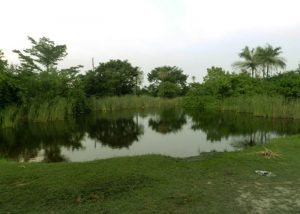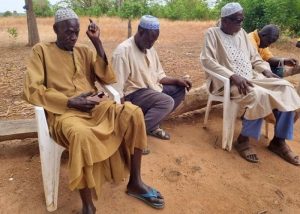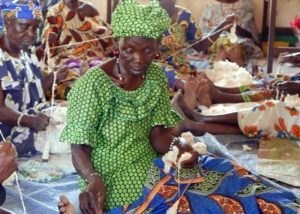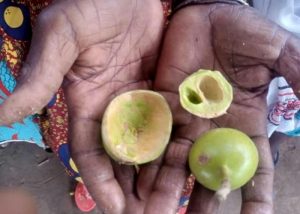001/2022
The Hunting Devil
Performing art, social practice and rituals
Banjul
The Gambia’s National Centre for Arts and Culture (NCAC) and the Heritage Management Organization (HERITΛGE) have proudly launched The Gambia’s Intangible Cultural Heritage Register, a project realised under the auspices of the country’s Ministry of Tourism, Arts and Culture.
The Register documents elements of The Gambia’s intangible cultural heritage (ICH) selected during the Pilot Inventory Project on the contribution of ICH to sustainable development in the country along with the role of this heritage in Distaster Risk Reduction (DRR) as established by the field findings of research conducted in 2021. Both activities were funded by UNESCO.
“This Register is a great step forward in our desire to conserve, preserve and interpretGambian culture,” says Hassoum Ceesay, Director General of the NCAC.
“The Register lists 30 elements of our ICH including the domain, description, bearer Community and pictures and videos to illustrate the element.”
Following the pilot inventory, the NCAC received extra funding to widen the inventory exercise to all Regions of The Gambia.
HERIΤΛGE is hosting the inventory on its digital infrastructure and working to enrich and disseminate the information included in the framework of the HerMaP Gambia program, an initiative co-funded by the European Union to upskill and strengthen the country’s heritage and tourism sectors.



001/2022
Performing art, social practice and rituals
Banjul
The Hunting Devil is a Masquerade, decorated with hunted animal apparels and leaves of raffia palm tree for costume. In the bearer community, the element is enacted during Christmas and New Year festivities.
Its origin can be traced from Freetown in Sierra Leone, where liberated Africans slaves were resettled.
The element is male dominated but both women and children also participate in the singing and dancing.

002/2022
Social practices, rituals and festive events
Bakau, Kanifing Municipality
‘‘Manyobitoo’’, is a ritual enacted in most Mandinka societies. The practice of the element is considered a big prestige for a girl child.
The ceremony is pre- planned as it requires adequate preparation. Usually, the timeline for the event is determined by the parents of the bride who fix a date for it. The ceremony begins at the bride’s parent’s house. Close relatives and neighbors grace the occasion.
At night, the bride (Manyoo), dressed in traditional costume, is accompanied to the house of the bridegroom.

003/2022
Knowledge and practices concerning nature and the universe
Jeshwang, Kanifing Municipality
Baby Wrapper also called Babampurango in Mandinka, Mbotu in Wolof, is used by women to lift their babies on their back.
Whenever this material gets burnt, an outbreak of diarrhea will affect all babies within the community. Ba Bampurang janno, a traditional ceremony where all nursing women and their children converge at the village square to enact the element. Rituals are performed by Kanyelengs (traditional communicators).
The element is practiced by the bearer community as a mitigating factor to curb the spread of the outbreak. The element is a women- led element.

004/2022
Traditional craftsmanship
Sukuta, Kombo North District, West Coast Region
Vegetable gardening is not just an economic activity for livelihood; it is a cultural heritage that is considered as a legacy in the bearer community of Sukuta.
The Practitioners use local techniques such site location; preparation of beds; applying compost and nursery bed.
They also use crude implements like the hoe; periodic turning of the soil to keep the seedlings healthy and mulching to minimize the effects of evapo- transpiration.
They also use traditional knowledge to store seeds for preservation.

005/2022
Knowledge and practices concerning nature and the universe
Lamin, Kombo North District, West Coast Region
Oyster harvesting is crucial for the lives and livelihood of members of the bearer community.
The element is practiced by women who paddle canoes into the creeks to obtain the oysters.
With the aid of gloves and simple tools such as knives, hammer and cutlasses, the women detach the fully grown oyster from mangroves, where it develops.
The women are accompanied by their daughters who take care of the younger children as they sing lullabies. It is a women-led practice.

006/2022
Social practice
Busumbala, Kombo North District, West Coast Region
Local Tribunal, also called Bulundaa in Mandinka, is a council of elders consisting of the eldest male member from each of the founding families of the community.
The council of elders ensures there is law and order in the community on all social issues as communal land tenure system, conflict resolution, and so on.
However, as the powers of the council of elders dwindles gradually, the role of each family head as the basic unit of society become more pronounced.

007/2023
Performing art
Badibu Badibu, North Bank Region
The Playing of the tabulo is the beating of a drum-like instrument by a practitioner, whose primary aim is to transmit a message that is understood by members of the bearer community. The instrument is locally known as tabulo in Mandinka and tabala in Wolof.
In the bearer community of Badibu Kerewan, there are three kinds of tabulo such as – the Fatty-ba tabulo, the Jumma tabulo and the Yessa kunda tabulo.
The frequency of playing the tabulo is determined by the information it relays.

008/2023
Performing art and social practice
Niumi Kanuma, North Bank Region
The practice of Sutoo Kankurang is led by the Nyansingbaa who determines the time and nature of the performance.
When the Sutoo Kankurang appears, it finds village women already converged at the village square as they sing dedicated songs. While enacting the performance, the masquerade dislodges its hat on the ground and makes use of its spiritual prowess to lift it with its leg to its head.
In the event the masquerade is unable to pick its hat, it will be assisted by the Nyansingbaaa through spiritual means.

009/2023
Social practice and rituals
Niumi Berending, North Bank Region
The keeping of the crocodile is known as Bamba malayandoo in Mandinka. It is fostered over a period of time as members of the bearer community avoid fishing from the stream in observance of a taboo – It is widely believed that whosoever hunts fish from the said stream shall encounters a mysterious death. This allows the crocodiles to fend freely on the fishes.
The stream is visited by many people who go there to seek prayers from the sacred crocodiles and sometimes swim in its waters.

010/2021
Disaster risk reduction and sustainable management of natural resources
Katchang, Upper Baddibou District, North Bank Region
Koo bondoo requires digging of pits which are filled with salty water and letting the solar radiation to evaporate all the liquid, leaving behind the crystal salt. The salt is then removed and washed with salty water to eliminate any dirt on it.
In most coastal communities, the activity of Koo bondoo is enacted by women.
Salt is used to preserve food and add flavor to their diets. Salt is also used as a trade commodity by practitioners.

011/2023
Social practice
Foni Kanilai, Foni Kansala District, West Coast Region
Wrestling locally called Kayegak in Jola and booray in Wolof is a form of traditional game which involves two competitors.
In the bearer community of Kanilai, the enactment of the element is led by a practitioner known as the Akittaw or, sometimes by a flute player.
The various forms of wrestling includes and not limited to Butebab (lifting of the opponent up); Nyanai (bowing down of the head); Egutai (holding the shoulder of the opponent and lift with the aid of your back); Fukaynaf (holding the leg of the opponent and push backwards); Ellongai (hitting of the opponent with the head) and Bolleirai (throwing of the opponent downwards).

012/2023
Performing art
Jakor, Foni Bintang District, West Coast Region
The Kumpo Masquerade is associated with the devil. It is dressed by an elderly man known as the Asolao eti Kumpoi using raffia palm leaves with ropes obtained from a baobab tree.
The stick attached on its head is obtained from a tree called Kalindak (elastic wood).
The Asolao eti Kumpoi leads the enactment of the element. A special tune is played with songs dedicated to the masquerade as it performs.
At the climax of the performance, the Kumpo dislodges its hat in a show of skillfulness and display of talent which it replicates as it takes back its hat.

013/2023
Social practice and rituals
Krunnulai Village, Foni Kansala District, West Coast Region
Butusob is a cultural dance performed by Jola men who are protected with jujus and ‘‘Kundanai (a protective medicinal food eaten for protection)’’. The men are often accompanied by women who beat two irons locally called ‘‘fulobokaf/kulobokak’’.
The beating of the metals by women is known as ‘‘enagayyeti balengse ngab’’, accompanied by singing; while the men brandish their knives and guns as they perform the dance.
At the climax, the highly fortified men begin to rub knives and razor blades over their bodies as they attempt to hurt themselves but unto no avail. Others with guns also try to shoot at themselves while the gun remain mute due to the protection by the Kundanai.

014/2023
Oral tradition and expression
Kiang Genieri, Lower River Region
The story of Foday Kaba Dumbuya is recollected by members of the bearer as a courageous man who razed many Soninke settlements but failed to emerge victorious during his encounter with the community of Genieri.
The story highlights heroism, resistance and ultimate subjugation of communities by Foday KabaDumbuya, a Jihadist leader.
However, despite fierce fight which led to many captives throwing themselves into the well against enslavement, Foday Kaba could not withstand the level of resistance and has to finally budge and fled the region.

015/2023
Oral tradition and expression
Kiang Kwinella, Lower River Region
The Nyansing denkiloolu are sung by members of the bearer community on specific occasions such as initiation ceremonies.
Young initiates are made to sing songs meant to inculcat e societal norms and values. The songs they sing bear connotative meanings which initiates are required to imbibe and grasp the meaning.
There are also proverbs which initiates are taught alongside the songs. These proverb are locally called Passingho. They also teach ethics, morals, norms and values meant to shape the initiates to become fully trained and informed.

016/2023
Social practice, rituals and festive events
Jarra Pakalinding, Lower River Region
The enactment of Barawulo is led by a camp Leader (Juju Mansa), who gives both verbal instructions and through gestures as the event unfolds.
Often, men who have undergone certain rituals and are spiritually prepared, take the lead in the procession as they brandish swords while they cut at themselves.
Women, who are lined up behind the men, sing indigenous songs and clap as they dance in a uniform pattern. The women also demonstrate the tilling of the soil with long hoes while they dance.
Three drummers also accompany the procession to amplify the songs being sung by women.

017/2021
Knowledge concerning nature and the universe
Bajana, Kiang West, Lower River Region
Jiidaano is the process of invoking mother nature to bless them with rain through prayers and sacrifices at shrines. It is a ritual performed in many rural communities. The practice of the element is enacted by women accompanied by children. Kola nuts and salt are used to share among themselves as charity.
In times of heavy downpour leading to flash floods, they resort to korondoo practice to cease rainfall.
On the contrary, in times of drought, the do the same for the downpour of rain to cease.
There are several kinds of korondoo; placing mound of sand at road intersection; kurulungo; piercing a live scorpion with a stick and drying it upside down; drying of a pair of bellows locally called Kurajaa.

018/2021
Knowledge concerning nature and the universe
Jali, Kiang West District, Lower River Region
Traditional healing known as moofing jaaraloo or moriyaa is practiced by many people for their health and wellbeing. Herbs such as kuntangJaawo, sinjango and sangfito and faara are used for the treatment of fusibaa (measles) and other diseases.
Herbalists obtain herbs from the forest where they often go in search of a particular medicinal plant. In the process, they recite incantations before they dig the medicinal plants.
Herbs are usually boiled or steamed, soaked or pounded and put into water for drinking or for bodily application.

019/2021
Knowledge and practices concerning nature and the universe
Kuli Kunda around Kiang West National Park (KWNP)
Traditional hunting or fayrlaa is practised by a certain clan or family called danoo. The community depends on this family for wild meat nutrition.
The practice begins at home with a series of incantations or spiritual soothsaying. Hunting is practiced by men in small groups or individually, in the bush and during the night.
Hunters usually return home at dawn. They use guns, knives, cutlasses and sometimes bows and arrows as weapons, and they take dogs with them to chase the prey.

020/2023
Social practice and rituals
Kaur Wharf Town, Central River North
Lip and gum tattooing Also called Tukagol/sukagol is largely practiced by the Toro boo, Laubeh and Chubalos sections of the Fula tribe.
The element is carried out using a set of thorns or needles used to pierce the gums or lips of the doer.
While women practice tattooing to beautify themselves; men do it as a curative measure. A red bean-like seed locally called Fantu is mixed with the spilled blood of the tattooed person and used as Juju for protection.

021/2023
Social practice and Traditional craftsmanship
Kerr Ramatoulie, Central River Region North
Pottery also locally called Tabaah ndaal is the molding of clay into objects of various sizes and pattern. The practice of the element is enacted by women who belong to the Nyenno clan.
They obtain the clay from the swamps which they mold into different objects and later burnt into finished product. Usually, the collection of raw material is done during the dry season and stored at homes.
The objects produced by them are either used for household usage or sold out at the weekly market called Lumo. Their female children do also make toys out of the residue of clay.

022/2023
Social Practice and festive event
Kudang village, Central River South
Munkutuwoo is the pounding of rice grains into rice paste and baked into cake. The practice of the element involves series of stages. Rice cake festival is often held during the begining of the farming season when the Wuri Kankurang appears and makes certain utterances which signifies the scheduling of the date for the event.
Other masquerades that participate at the event are the Nyankiri and Passo.
The purpose of the ceremony is primarily aimed at praying to their gods for a bumper rainy season.

023/2023
Traditional craftsmanship
Majumba village, Central River Region North
Bamboo knitting involves the collection of bamboo sticks from the bank of the River Gambia, stich them into Tara beds and furniture. In the community of Majumba, both men and women practice the element as men make beds and chairs whereas women make stools and brooms.
Due to the scarcity of the bamboo plants in the swamps, most practitioners do harvest the plant before they are fully matured which affects the durability of the products.

024/2023
Social practice and Traditional craftsmanship
Mamud fana, Central River Region South
The traditional food preparation of Chere and Nyelen involves distinct stages. Harvested coose or corn is crushed through pounding by women. Later, the powdered product is then rolled by women with the aid of bare hands.
Once it is fully heated, the steamed version and is thoroughly mixed with a kind of sap locally called Lallo from a tree called Mbeb which adds flavor to the food and makes it slippery.
The re-steaming of the Chere or Nyelen is done intermittently on intervals of up to seven times.

025/2023
Social Practice
Sowe Kunda, Central River Region South
Ndewtungu is a typical Fula Wedding Ceremony in which both the bride and the groom are wed. The process of the ceremony lasts for four days and the methodology of its practice is peculiar to the Fula community.
As a process, a marriage ceremony precedes the wedding during which, the prospective husband provides all that is required including a young female cow (heifer) locally called Tengeh.
The wedding ceremony lasts for four days and the first three days are held at the compound of the bride. The bridegroom also attends the wedding.

026/2023
Traditional craftsmanship
Borokanda Kasseh, Upper River Region North
Weaving of cotton used to be locally practiced in most communities in the Upper River Region of The Gambia. This was due to the cultivation of cotton as the main cash crop in the region.
The traditional method of weaving is done by both men and women, who often collect the raw cotton from the farm to their makeshift workshops for production.
After the harvest of the cotton, women often collect the wool to produce thread by the use of a locally made loom.

027/2023
Social practice & rituals
Sotuma Samba Koi, Upper River Region South
Palm wine, also called Teng dolo soo in Mandinka; Kawa wak in Jola; Jam sengar in Wolof and Chokgol in Fula is the tapping is the process of extracting sap of various species of palm trees. The process of palm wine tapping comprise of climbing the palm tree, making small pores in the trees’ bark with the aid of a cutlass or knife.
The most commonly tapped palm trees are the oil palm as well as the raffia palm. Palm wine is a mildly alcoholic drink, often consumed fresh but can also be stored to ferment.
The use of palm wine by practitioners is usually for diverse reasons. While it is primarily used for consumption and in some cases for medicinal reasons, it is also used in almost all rituals.

028/2023
knowledge and practices concerning nature and the universe
Sutukoba, Upper River Region North
The process of gathering, processing and preservation of leaves, fruits and seeds is done in many Gambia rural communities. Among the many food gathered by the bearer community, Wulakono dutoo, a kind of tree which grows wildly in the forest.
The element is also called Ndimbe in Wolof. The unripe fruit is often peeled, dried to be preserved and later used for cooking.

029/2021
Disaster risk reduction and sustainable management of natural resources
Badidibu Minteh Kunda. North Bank Region
Thatching or tibadaa is the craft of building a roof with the use of dry vegetation called njamaloo, a type of locally available grass to shed water away from the inner roof.
Increasingly uncommon, it is still an important source of shelter for rural communities.
There are two forms of thatching – tibadaa and tibang singo. The latter is used to revamp a house already thatched.
Njamaloo is harvested and plaited into braids to cover a roof or make a fence around the compound. At the apex of the roof, kukuwo sticks are covered by kumbirinyasso grass to shape the structure like a hat.

030/2021
Traditional craftsmanship and knowledge concerning nature and the universe
Baddibu Katchang, North Bank Region
Kayaa or sora (using a reed basket for fishing), dolingo (using hooks to catch fish in shallow waters), kojewo (using a gourd and then removing the water) and bamoo (creating a blockage so that fish are stranded when the tide ebbs) are traditional fishing methods practiced in the bearer community.
Both women and men within communities contribute to the practice of these techniques, which are sourced locally: a weaver will fabricate the net used for the kayaa from river reed, and a carver will make the hooks from bone or scrap metal.
